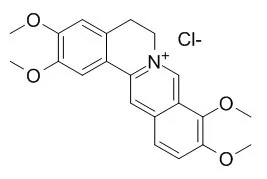| In vitro: |
| Acta Chim. Sin. Chinese Edition, 2009, 67(21):2511-6. | | Investigation on the Anti-Candida albicans Effect of Palmatine Hydrochloride Based on Microcalorimetry and Principal Component Analysis[Reference: WebLink] |
METHODS AND RESULTS:
Using an LKB-2277 bioactivity monitor, the metabolic power-time curves of Candida albicans (C albicans) growth affected by Palmatine hydrochloride were measured at 37 degrees C, then nine quantitative thermokinetic parameters were obtained from these curves and investigated by principal component analysis (PCA) to evaluate the anti-C. albicans effect of Palmatine hydrochloride. The results showed that the anti-C. albicans effect of this compound was mainly influenced by the growth rate constant (k(2)) and maximum power output P(m)(2) of phase II, and could be easily, quickly and exactly evaluated by analyzing the change of these two quantitative parameters.
CONCLUSIONS:
This work provides a useful method and idea for further evaluating the anti-bacterial effect of other drugs and compounds. |
|
| In vivo: |
| Proceedings of the National Academy of Sciences, 2014, 48(3):461-471. | | Palmatine hydrochloride improves motor dysfunction in streptozotocin-induced diabetic rats.[Reference: WebLink] | Diabetes induces motor dysfunctions, Palmatine is an isoquinoline alkaloid, with anti-diabetic and antioxidant activities. This study was conducted to evaluate the effect of Palmatine on motor dysfunction in STZ-induced diabetic rats.
METHODS AND RESULTS:
In this experimental study, 32 male wistar rats were randomly allocated into control, Palmatine-treated non-diabetic, diabetic and Palmatine-treated diabetic groups. Diabetes was induced by STZ administration at the dose of 55 mg/kg/bw, intraperitoneally. Palmatine hydrochloride was administered subcutaneous at doses of 10 mg/kg/bw per day for a period of 6 weeks, one week after induction of diabetes. Blood glucose level was measured 1, 3, 5, 7 weeks after STZ injection. Locomotor activity tests including Y maze, grip-traction and inclined plane tests were performed to determining locomotor activity. Results: In Y maze test, the number of arms entered significantly increased in Palmatine-treated diabetic group compared to diabetic group (P<0.05). Grip traction and inclined plane tests significantly increased in Palmatine-treated diabetic group compared to diabetics animals (P<0.05).
CONCLUSIONS:
Palmatine hydrochloride administration for 6 weeks improves motor dysfunctions in streptozotocin-induced diabetic rats. | | Pharmacol Res . 2018 Nov;137:34-46. | | Palmatine ameliorated murine colitis by suppressing tryptophan metabolism and regulating gut microbiota[Pubmed: 30243842] | | Abstract
Inflammatory bowel disease (IBD), majorly include Crohn's disease (CD) and ulcerative colitis (UC), is chronic and relapsing inflammatory disorders of the gastrointestinal tract, which treatment options remain limited. Here we examined the therapeutic effects of an isoquinoline alkaloid, Palmatine (Pal), on mice experimental colitis induced by dextran sulfate sodium (DSS) and explored underlying mechanisms. Colitis was induced in BALB/c mice by administering 3% DSS in drinking water for 7 days. Pal (50 and 100 mg kg-1) and the positive drug Sulfasalazine (SASP, 200 mg kg-1) were orally administered for 7 days. Disease activity index (DAI) was evaluated on day 8, and colonic tissues were collected for biochemistry analysis. The fecal microbiota was characterized by high-throughput Illumina MiSeq sequencing. And plasma metabolic changes were detected by UPLC-MS. Our results showed that Pal treatment significantly reduced DAI scores and ameliorated colonic injury in mice with DSS-induced colitis. Mucosal integrity was improved and cell apoptosis was inhibited. Moreover, gut microbiota analysis showed that mice received Pal-treatment have higher relative abundance of Bacteroidetes and Firmicutes, but reduced amount of Proteobacteria. Moreover, Pal not only suppressed tryptophan catabolism in plasma, but also decreased the protein expression of indoleamine 2,3-dioxygenase 1 (IDO-1, the rate-limiting enzyme of tryptophan catabolism) in colon tissue. This is consolidated by molecular docking, which suggested that Pal is a potent IDO-1 inhibitor. Taken together, our findings demonstrate that Pal ameliorated DSS-induced colitis by mitigating colonic injury, preventing gut microbiota dysbiosis, and regulating tryptophan catabolism, which indicated that Pal has great therapeutic potential for colitis.
Keywords: Gut microbiota; Palmatine; Tryptophan metabolism; Ulcerative colitis. |
|






 Cell. 2018 Jan 11;172(1-2):249-261.e12. doi: 10.1016/j.cell.2017.12.019.IF=36.216(2019)
Cell. 2018 Jan 11;172(1-2):249-261.e12. doi: 10.1016/j.cell.2017.12.019.IF=36.216(2019) Cell Metab. 2020 Mar 3;31(3):534-548.e5. doi: 10.1016/j.cmet.2020.01.002.IF=22.415(2019)
Cell Metab. 2020 Mar 3;31(3):534-548.e5. doi: 10.1016/j.cmet.2020.01.002.IF=22.415(2019) Mol Cell. 2017 Nov 16;68(4):673-685.e6. doi: 10.1016/j.molcel.2017.10.022.IF=14.548(2019)
Mol Cell. 2017 Nov 16;68(4):673-685.e6. doi: 10.1016/j.molcel.2017.10.022.IF=14.548(2019)